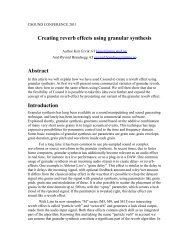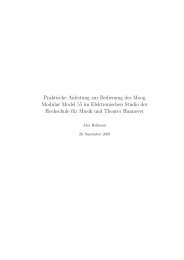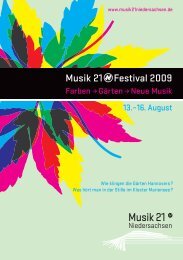Ervik_Brandtsegg2.pdf
Ervik_Brandtsegg2.pdf
Ervik_Brandtsegg2.pdf
You also want an ePaper? Increase the reach of your titles
YUMPU automatically turns print PDFs into web optimized ePapers that Google loves.
Another way to create along tail on a sound object is totime stretch it. This is easily doneusing granular synthesis. In thefirst track of figure 2, we can seea small sound object. One can“chop” the sound object intograins and stretch the duration ofthe entire sound object like anaccordion, leaving empty spacebetween each grain. This is donein the second and third track of the Fig 2: Granular synthesis time stretchfigure. In track four we can se thatby filling the empty spaces between the grains with sound from nearby regions, we get alonger sound object with the same structure as the shorter one, still retaining the originalpitch.When doing time stretch using granular synthesis, we urge to avoid artefacts tothe extent possible. The most common artefacts are smearing of transients (due tooverlapping long grains), and amplitude modulation sidebands (due to high grain rate andperiodic grains). With low grain rates (less than 30 Hz), the pitch of the sound object isperceived through transposition of the source audio, as the original source waveform isnot distorted by granular amplitude modulation. We can to some extent avoid the AMeffect at higher grain rates too, by using a small random deviation on the sample positionfor reading grains. One way to create a smooth time stretch effect is by using a grain rateof about 30 – 40 grains per second, overlapping grains (3 overlaps seems to be OK) and atiny random offset on the sample position. To achieve a broad stereo image one candouble the grain rate and mask every other grain to the left and right stereo channels.Time stretching real time audioThere are obviously some conceptual problems with the idea of time stretching in realtime. When a sound is played in its original tempo, at the same time as the same sound isplayed back in a lower tempo, the lower tempo playback will lag behind the original, andincreasingly so over time. In real time processing this is a problem because shortly afterthe effect instrument is started, the time between the playback position of the originalsignal and the playback position of the stretched signal is far to large for it to sound like areverb effect. Letting the stretching process “skip” some parts of the incoming sound cansolve this problem, as this will let us align the two playback positions on a periodic basis.This is not ideal either, because it will be unpredictable which part of the incomingsignal which will be skipped and which part will be stretched.A better approach to real time time stretch is to use several buffers and severalinstances of the time stretch instrument simultaneously (TimeStretchReverb.csd [6]).Using the “schedkwhen” Csound opcode we can trigger a Csound instrument to recordincoming sound to a buffer (a Csound table). The same opcode can also be used to start aCreating reverb effects using granular synthesis – page 3 of 6
granulation process of the recorded sound. A metronome and a counter can keep track ofwhich table to write to, and when to start and stop the instances of the recording andplayback instruments. In this manner, we can allow several overlapping time stretchinstances simultaneously. This can also be seen as a granular process, so we have ineffect several crossfading layers of granular synthesis running on top of each other, ornested granular synthesis, if you wish. What we mean with nested granular synthesishere is that we have an inner and an outer granular processing loop. The inner loop doesthe audio time stretching, while the outer loop performs the skipping and crossfading oftime stretch layers, "catching up" with real time. It can also be preferable to let therecording instances overlap each other to allow for the random offset on the sampleposition.Writing to buffer Reading from buffers Fig. 3 Writing audio to 8 different buffers, at the same time as they are played back.In our example we’ve used 8 buffers, recording 0.5 seconds to each buffer. Thisfraction of sound is time stretched by a factor of 8 so playback of the sound segment lasts4 seconds (see figure 1). We’ve also applied an envelope with a slow attack and a slowrelease to get all the instances to overlap each other smoothly. The parameter values hasbeen tweaked by empirical adjustments, so that the reverb tail is long enough, and at thesame time it is not too unpredictable when an incoming sound “returns” from the audioprocessing. There will be a small periodically changing pre-delay on the reverb effect dueto the moving read position on the time stretched playback. Using more layers ofoverlapping time stretch would make the effect smoother and the variations in pre delaysmaller. The reverberation time can be adjusted by controlling the time stretch ratio. Thereverb time can be calculated with the formula:T =t2− 0.5where T is the reverb time in seconds and t is the time stretch ratio.Implementation considerationsOur granular reverb implementation uses the partikkel opcode [7]. This opcode wasinspired by Curtis Roads book “Microsound” [8] and is capable of generating all theCreating reverb effects using granular synthesis – page 4 of 6
References[1] Ableton – http://www.ableton.com/live-8[2] Line 6 – http://line6.com/m9/models.html[3] Smith, Julius O. (2006) Physical Audio Signal Processing, web resourcehttp://www.dsprelated.com/dspbooks/pasp/Comb_Filters.htmlhttp://www.dsprelated.com/dspbooks/pasp/Schroeder_Allpas_Sections.htmlhttp://www.dsprelated.com/dspbooks/pasp/Freeverb.htmlhttp://www.dsprelated.com/dspbooks/pasp/FDN_Reverberation.html[4] Boulanger, Richard (2000) The Csound book, page 507. MIT Press, Cambridge,Massachusetts.[5] <strong>Ervik</strong>, Kim csound exsample nr1: PartikkelDly.csdhttp://folk.ntnu.no/kimer/csoundconference2011/PartikkelDly.csd[6] <strong>Ervik</strong>, Kim csound exsample nr2: TimeStretchReverb.csdhttp://folk.ntnu.no/kimer/csoundconference2011/TimeStretchReverb.csd[7] Brandtsegg, Ø. Saue, S. and Johansen, T. (2011) Particle synthesis, a unified modelfor granular synthesis. Linux Audio Conference 2011.http://lac.linuxaudio.org/2011/papers/39.pdf[8] Roads, Curtis (2001) Microsound. MIT Press, Cambridge, Massachusetts.Creating reverb effects using granular synthesis – page 6 of 6










